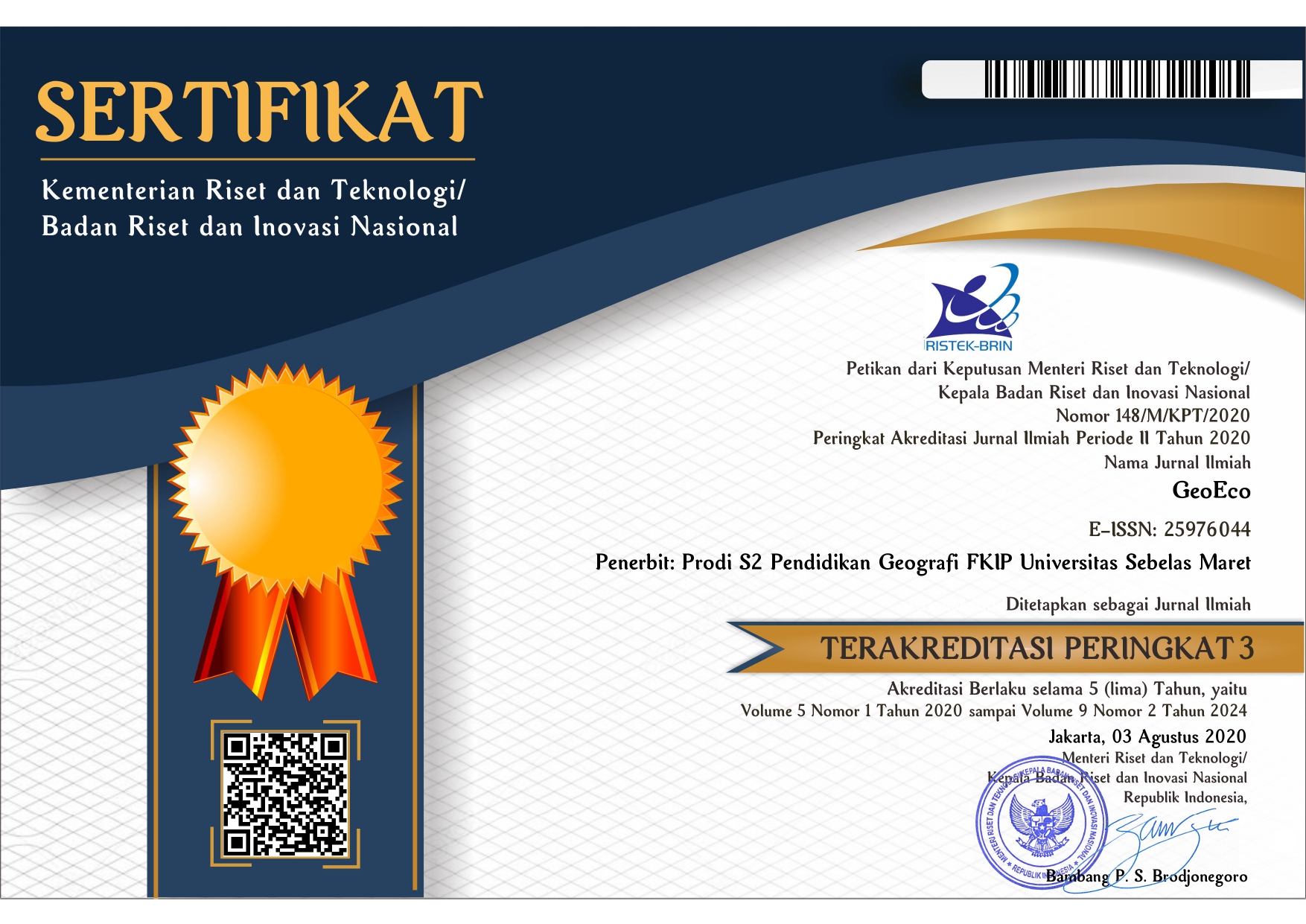ENHANCING FARMER’S WELL BEING THROUGH THE AGRICULTURE LAND PROVISIONS IN WEST NUSA TENGGARA
Abstract
While carrying out its essential duties to provide adequate foods for people, the agriculture sector is facing sustainability issues. The study presents a case study of West Nusa Tenggara (NTB), whereby an increase of urban expansion activities has begun to create a centrifugal force to the province that is popularly called as the granary of Indonesia. Urban settlements slowly leapfrogged to the outskirts and reduced the size of prime agricultural lands. Moreover, existing planning policies were unable to control the situation and many farmers leave their jobs because the setback of farmers wellbeing. The size of agricultural land is highly influential towards farmer motivation to stay engaged in the farming sector. Applying qualitative methods, this study examined the minimum area of agriculture land (focusing on paddy field) to promote farmer’s well-being following three steps of the analytical framework: total agricultural production estimation, the average well-being estimation, and the prediction of minimum land provision for the average well-being. After all, one of the key important findings reveals that the average of minimum agricultural land to ensure famers wellbeing for the whole NTB Province is 0.74 Ha.
Keywords
Full Text:
PDFReferences
Adrianto, D. W., Aprildahani, B. R., Subagiyo, A. (2013). Tackling the Sprawl, Protecting the Parcels: An Insight into the Community’s Preference on Periurban Agricultural Preservation. Spaces and Flows: An International Journal of Urban and ExtraUrban Studies, 3, 115–125. https://www.researchgate.net/profile/Olon-Dotson/publication/307765536_Physical_Places_and_Ideological_Spaces/links/5832ef3b08ae102f0736592c/Physical-Places-and-Ideological-Spaces.pdf#page=128 Arvianti, E. Y., Masyhuri, M., Waluyati, L. R., & Darwanto, D. H. (2019). Gambaran Krisis Petani Muda Indonesia. Agriekonomika, 8(2), 168–180. https://doi.org/10.21107/agriekonomika.v8i2.5429 Ayambirea, R. A., Amponsaha, O., Pepraha, C., & Takyi, S. A. (2019). A review of practices for sustaining urban and peri-urban agriculture: Implications for land use planning in rapidly urbanising Ghanaian cities. Land Use Policy, 84(2019), 260–277. https://doi.org/10.1016/j.landusepol.2019.03.004 European Parliament Research. (2018). Small Farmers [What Europe Does For You]. https://epthinktank.eu/2018/05/19/small-farmers-what-europe-does-for-you/ (19 Mei 2018) FAO. (2015). The economic lives of smallholder farmers. In Food and Agriculture Organization of the United Nations. United Nations. https://doi.org/10.5296/rae.v6i4.6320 Goverment of Indonesia. (2009). Undang-Undang Nomor 41 Tahun 2009 tentang Perlindungan Lahan Pertanian Pangan Berkelanjutan. Goverment of Indonesia. Indonesia Centre of Statistics Bureau. (2014). Potensi Pertanian Indonesia (Analisis Hasil Pencacahan Lengkap Sensus Pertanian 2013). Indonesia Bureau of Statistics (BPS). Indonesia Centre of Statistics Bureau. (2020). Indonesia in Figure. Indonesia Bureau of Statistics (BPS). Kosanlawit, S., Soni, P., & Shivakoti, G. P. (2017). The relationship between effective and equitable water allocation, local rice farmer participation and economic well-being: Insights from Thailand’s Chiang Mai Province. Water (Switzerland), 9(5). https://doi.org/10.3390/w9050319 Kumar, A., Mishra, A. K., Sonkar, V. K., & Saroj, S. (2020). Access to credit and economic well-being of rural households: Evidence from Eastern India. Journal of Agricultural and Resource Economics, 45(1), 145–160. https://doi.org/10.22004/ag.econ.298439 Latruffe, L., & Piet, L. (2014). Does land fragmentation affect farm performance? A case study from Brittany, France. Agricultural Systems, 129, 68–80. https://doi.org/10.1016/j.agsy.2014.05.005 Lu, W., & Horlu, G. S. A. (2017). Economic well-being of rural farm households in Ghana: A perspective of inequality and polarisation. Journal of Rural Studies, 55, 248–262. https://doi.org/10.1016/j.jrurstud.2017.08.013 Ma, W., Nie, P., Zhang, P., & Renwick, A. (2020). Impact of Internet use on economic well-being of rural households: Evidence from China. Review of Development Economics, 24(2), 503–523. https://doi.org/10.1111/rode.12645 Markussen, T., Fibæk, M., Tarp, F., & Tuan, N. D. A. (2018). The Happy Farmer: Self-Employment and Subjective Well-Being in Rural Vietnam. Journal of Happiness Studies, 19(6), 1613–1636. https://doi.org/10.1007/s10902-017-9858-x Menteri Tenaga Kerja dan Transmigrasi Indonesia. (2012). Peraturan Menteri Tenaga Kerja dan Transmigrasi Republik Indonesia Nomor 13 Tahun 2012 tentang Komponen dan Pelaksanaan Tahapan Pencapaian Kebutuhan Hidup Layak. Milton, C. C. (2003). Innovating Conservation Agriculture: The Case of No-Till Cropping. Rural Sociology, 68(2), 278–304. Nipers, A., Pilvere, I., & Krievina, A. (2015). Sizes of Farmland Necessary for Earning Minimum Income and Investment Required for Farms of Various Specialisation in Latvia. Engineering for Rural Development Engineering For Rural Development Jelgava, 20-22.05. NTB Province Statistics Bureau. (2017). Hasil Survei Struktur ongkos Usaha Tanaman Padi 2017/Result of Cost Structure Paddy Cultivation Household Survey 2017. NTB Province Statistics Bureau. (2020a). NTB Province in Figure. NTB Bureau of Statistics (BPS). NTB Province Statistics Bureau. (2020b). Statistik Harga Produsen Gabah Provinsi Nusa Tenggara Barat 2019. Parnell, S., & Oldfield, S. (2014). The Routledge Handbook on Cities of the Global South. Routledge. https://doi.org/10.4324/9780203387832 Pochanasomboon, A., Attavanich, W., & Kidsom, A. (2020). Impacts of Land Ownership on the Economic Performance and Viability of Rice Farming. Land, 9(71), 1–18. Rusdiana, S. (2014). Analisis Pendapatan Usaha Pertanian Dan Peternakan Kerbau Di Lombok, Nusa Tenggara Barat. Journal of Agriculture, Resource and Environmental Economics, 1(2), 56–67. https://doi.org/10.29244/jaree.v1i2.11802 Saxby, H., Gkartzios, M., & Scott, K. (2018). ‘Farming on the Edge’: Wellbeing and Participation in Agri-Environmental Schemes. Sociologia Ruralis, 58(2), 392–411. https://doi.org/10.1111/soru.12180 Setiawan, I. (2000). Dinamika Pemberdayaan Petani: Sebuah Refleksi dan Generalisasi Kasus di Jawa Barat. Bandung: Widya Padjadjaran. Sumarno. (2006). Periodisasi Musim Tanam Padi Sebagai Landasan Manajemen Produksi Beras Nasional. Sinar Tani, 3136. Sunderlin, W. D., Angelsen, A., Resosudarmo, D. P., Dermawan, A., & Rianto, E. (2001). Economic crisis, small farmer well-being, and forest cover change in Indonesia. World Development, 29(5), 767–782. https://doi.org/10.1016/S0305-750X(01)00009-2 Susilowati, S. H., & Maulana, M. (2012). Farm Business Land Size and Farmers Welfare: Smallholders Existence and Agrarian Reform Urgency. Analisis Kebijakan Pertanian, 10(1), 17–30. Swinnen, J., & Knops, L. (2013). Land, Labour and Capital Market in European Agriculture. Brussel: Centre for European Policy Studies. The Business Line. (2018, August). Average farm landholding size shrinks to 1.1 ha. Agri Business. https://www.thehindubusinessline.com/economy/agri-business/average-farm-landholding-size-shrinks-to-11-ha/article24719240.ece. Väth, S. J., Gobien, S., & Kirk, M. (2019). Socio-economic well-being, contract farming and property rights: Evidence from Ghana. Land Use Policy, 81(April 2017), 878–888. https://doi.org/10.1016/j.landusepol.2017.04.023
Refbacks
- There are currently no refbacks.












.png)

